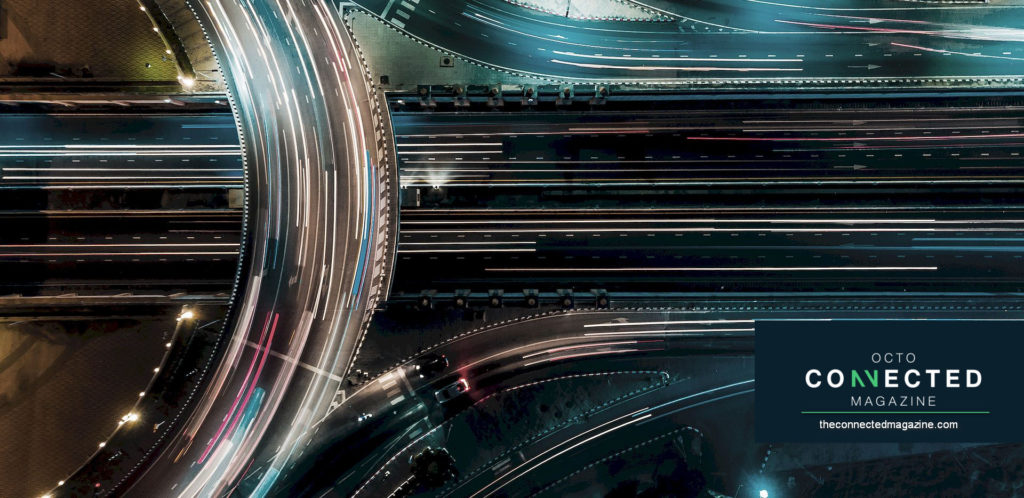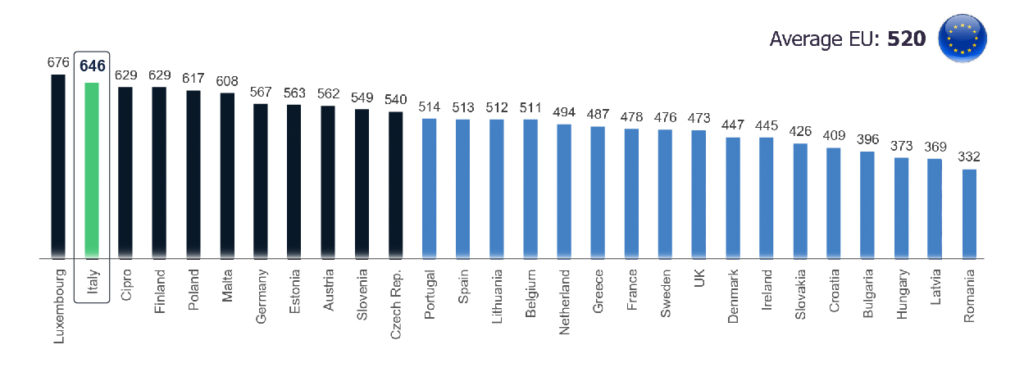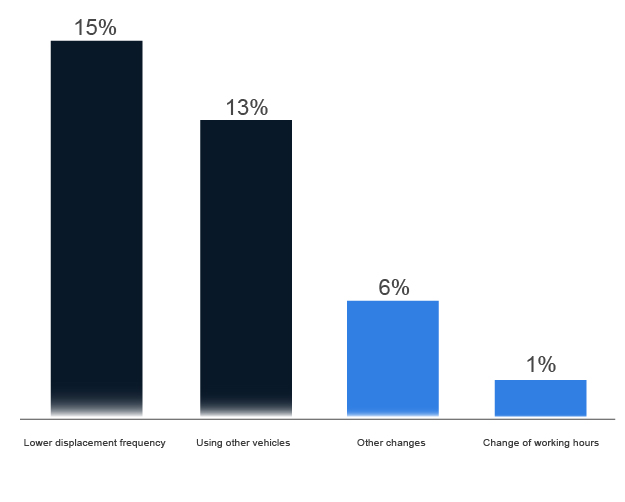
Today, Italy is the second European country in terms of motorization rate with approximately 646 vehicles per 1,000 inhabitants, second only to Luxembourg (676 vehicles/1,000 inhabitants) and with a much higher value compared to other European countries (Germany 567, Spain 513, France 478, United Kingdom 473). This figure testifies the extent to which Italians rely on cars: individual transport is worth 80% of total passenger traffic, with differences depending on the size of the city (in rural centers car has a share of over 70%, while in large urban centers car is used in less than 50% of trips).

An increase in population density in urban centers – globally by 2050 the population living in cities will increase by up to 80% compared to 2020 – poses increasing challenges for the ecosystem and mobility players. What would happen without changes in the world of mobility? In 2050, approximately 106 hours will be spent each year in city traffic (+51.4% compared to 2020); urban mobility will be responsible for the consumption of 17.3% of the planet’s resources by 2050; the time spent looking for parking, which is already about 4 days per year, will increase. In addition, mobility in cities will be increasingly responsible for climate change (already today 75% of global CO2 emissions are generated in cities).
Compared to these consolidated scenarios, one wonders what the impact of the Covid-19 pandemic on the way of living and moving around will be. Compared to a year ago, 33% of Italians declared that they have changed their mobility needs, modifying the frequency of their movements, their schedules, and the type of means of transport. In addition, 51% of citizens said they will limit their travel for personal activities (i.e., leisure) in the post Covid-19.

The points of attention are therefore three: the need for a new mobility model that makes cities usable by an increasing number of people; a smart mobility that reduces impacts on the environment; an ad hoc mobility resilient to future exogenous shocks.
The European House – Ambrosetti and OCTO Telematics believe that these issues can be addressed by developing the concept of Smart Mobility & Connected Mobility. Data and digital technologies make it possible to develop new models of synchronized management of urban infrastructures and cities.
The so-called Smart Mobility applications are framed in a Smart City context, a model of city development that is gathering more and more investments worldwide: more than 100 billion Euros have been invested in 2020, up to 18.9% compared to 2019. Smart Mobility, in addition to improving the efficiency of travel in cities, is considered an enabler of the so-called “Vision Zero”, a strategy aimed to eliminate all fatal road accidents and serious injuries, while increasing safety, sustainable and equitable mobility for all. Originated in Sweden in the 1990s, Vision Zero is now expanding worldwide.
The Vision Zero strategy is seen as truly disruptive to the status quo for two reasons: first, Vision Zero recognizes that people sometimes make mistakes, so the road system and related policies should be redesigned to ensure that inevitable mistakes do not result in serious or fatal injuries. This means that system designers and public decision makers should improve road environment, policies, and other related systems to reduce the severity of crashes. Second, Vision Zero is a multidisciplinary approach, bringing together multiple stakeholders to address the mobility problem, which by its nature is considered complex. In the past, meaningful, interdisciplinary collaboration between local traffic planners and engineers, policymakers, and public health professionals has not been the standard modus operandi. Vision Zero recognizes that many factors contribute to safe mobility – including street design, speed, behaviors, technology, and policies – and sets clear goals to achieve the primary goal of zero deaths and serious injuries.
In addition, OCTO’s Vision Zero, achievable through the widespread application of enabling technologies, leads to broaden the perspective by including three strands: Zero Crash, thanks to autonomous driving systems and the constant connection of vehicles, it will be possible to achieve almost zero road accidents (in Italy, almost 9 people per day lose their lives due to road accidents); Zero Pollution, the spread of autonomous and connected vehicles will be driven by zero-emission vehicles, leading to a reduction in emissions (currently light vehicles are the third largest source of particulate matter in Italy); Zero Traffic, the connection between cars (Vehicle-to-Vehicle, V2V) and of cars with the surrounding infrastructure system (Vehicle-to-Infrastructure, V2I) will make it possible to efficiently move leading to an important reduction in traffic.
The use of data, from various sources (i.e., vehicle, urban environment, mobility infrastructure, buildings, citizens), makes it possible to realize this central vision for the development of cities. For example, Connected Mobility will make it possible to: manage traffic, developing systems and models to optimize the flow of vehicles and reduce congestion; make the search for parking more efficient, reducing time spent and fuel wasted; encourage the use of “green” engines and driving styles; prevent accidents, increasing the probability of saving a life and improving the action of rescuers; manage intermodal systems, increasing their efficiency by creating win-win solutions between private and collective mobility.
In line with what has been described above, the initiative of OCTO Telematics and The European House – Ambrosetti aims to investigate the state of mobility in Italy and define a new development model of the ecosystem in order to create a real smart and connected mobility. In particular, the term “Connected Mobility” means the interconnection of the vehicle with analytical platforms able to offer services both inside and outside a vehicle, allowing the driver and other passengers to enjoy an experience of ownership and use of the vehicle, the ecosystem of players a more efficient asset management and the offer of new services thanks to innovative technological solutions.
Vehicle connectivity will generate value in three areas: drivers and passengers, mobility operators and infrastructure. Vehicle users will be able to carry out activities other than driving while moving around, organize their journeys automatically based on commitments and improve the efficiency of their trips. Mobility operators, such as system and fleet managers, will be able to use the data collected by connected vehicles to improve their services and, at the same time, improve vehicles’ management, for example with preventive maintenance interventions. It will also be possible to use the vehicle as an interface capable of conveying new and innovative services: for example, the ability that a connected car would have in monitoring health status of users by enhancing the capabilities of wearable devices. Finally, the various infrastructures will be able to communicate with each other, with connected vehicles and with other devices, such as smartphones. In this sense, the creation of a seamless interconnected ecosystem is envisioned.
Ultimately, it can be said that the possibility of creating complex virtual models, enabled by the growing availability of data generated by vehicles and other components of mobility systems, will therefore make it possible to improve the use and livability of cities, developing ad hoc infrastructures and efficient intermodal travel management systems. It will also make it possible to create an advanced consumer experience in which the user will have at his/her disposal a plurality of advanced services more in line with his/her expectations.
The next article in this series will examine the consumer trends and technological evolutions that are revolutionizing the mobility ecosystem, releasing new trapped value that can only be captured through the development of new business models and ecosystem approaches.
Authors:
Alessandro Viviani : Senior Consultant – Innotech Hub
Corrado Panzeri : Associate Partner – Head of InnoTech Hub
The European House – Ambrosetti